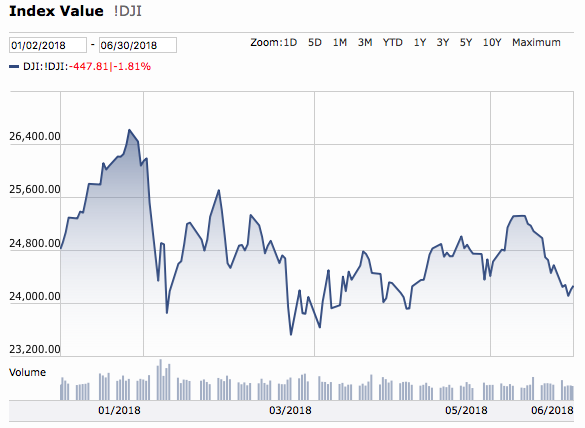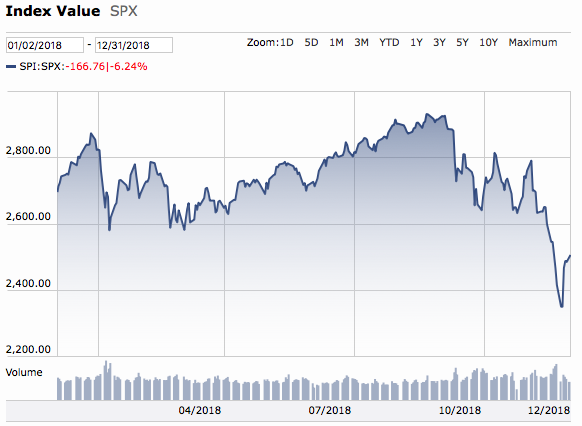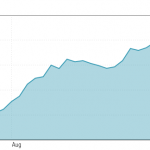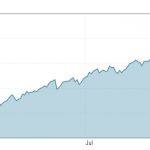The Markets in 2018
Wow, time sure does fly.
We’re already done with the second quarter of 2018 and steaming full bore into the third.
If I hadn’t taken the time today to examine the Q2 and 2018 first half charts for the major indices, it might have been the end of Q3 before I got around to it.
Luckily I didn’t let time slip away to that extent.
Let’s sit back together and see what stocks have done over the past six months, shall we?
2018 Second Quarter Returns
The Dow Jones Industrials rose a paltry 0.70% or 168.30 points from April through the end of June.
The S&P 500 increased a somewhat better 2.88% or 76.06 points during the period.
While the Nasdaq jumped 6.31% or 445.87 points during the second quarter of 2018.
Overall, not bad returns for Q2. But not stellar returns, either.
Now let’s take a look at how the markets performed during the first half of 2018.
2018 First Half Returns
The Dow fell 1.81% or 447.81 points from January through June of this year.
The S&P 500 inched up 1.67% or 44.76 points during that six-month stretch.
And the Nasdaq left the other two indices in the dust, climbing 8.79% or 606.91 points for the first half of 2018.
Obviously, looking at these returns, especially for the first half of 2018, we’ve seen mediocre gains outside of the Nasdaq, or more specifically a select number of tech stocks.
In fact, many reports tout that the market gains thus far in 2018 are due to roughly a dozen tech stocks…the majority of stocks are holding in a fairly tight trading range, limiting market gains and losses.
Which is not unexpected. Many who follow the markets called for little to no gains for 2018. And if you look at the half-year returns, they’ve been right on…at least so far.
We’ve still got 6 months (roughly) to go in 2018, and a mid-term election to get through before we see how 2018 really shakes out.
Why This Matters
Why does a site focused on money saving tips, tricks, and deals bother talking about stock market returns?
Well, because of the big picture.
Even if you, as an individual, have no money at all in the stock market, how it performs will affect your bottom line.
And if you have a 401(k) or Individual Retirement Account, market returns will mean all that much more.
Outside of the obvious – your retirement nest egg growing ever larger – how in the world could market performance possibly mean anything to those with little to no exposure to stocks?
Let me answer that with a tidbit from an interview I saw yesterday. Marc Levine, the Illinois State Board of Investments chair was interviewed on CNBC regarding pension fund returns and changes Illinois (and other states’ pension funds, too) has made to boost overall returns.
Regular readers of Savings Beagle, and specifically my quarterly stock market updates, know I’ve hounded on the pension crisis (both government and private company) facing the U.S in just about every quarterly update. Too much has been promised to current and future retirees, and not enough money has been set aside, or earned, to meet those obligations.
You see, pensions rely on current employees contributions, but also investment returns of 7-8% annually to even come close to meeting the benefit payments that have been promised. While recent stock market returns have met or exceeded those benchmarks, there have been a number of years where returns came nowhere near what is required. And when you factor in the crash of 2009, most pension funds still have a long way to go to be whole.
Back to Mr. Levine’s interview (you can view the full interview below). Toward the end of the interview, after he discussed changes the pension fund managers have made to better the funds’ returns, he conceded that Illinois’ government pension funds were still only 40% funded and that investment returns, no matter the percentage gain, will never be able to make up the deficits the funds are facing.
Saving for retirement: The hunt for the outperforming pension fund from CNBC.
What will happen?
Well, one of two things, or a combination of the two.
- Retirees will not receive the pension payments they had hoped when cuts are made to levels more commensurate with the money the pension funds really have.
- Taxes will go up for everyone to cover the pension shortfalls.
Both of which have negative consequences for not only individuals but for the greater U.S. economy as well.
While this specific example pertains to Illinios, unfortunately, a majority of other states’ pension funds are in exactly the same situation.
And that’s not even considering that the federal government’s Social Security program is significantly underfunded as well.
Okay, I’m done, although I could list off a number of other fiscal problems our governments are facing, problems that governments at the local, state, and the federal levels are hoping an ever-rising stock market will help to alleviate.
Bottom line, in the near future, all governmental entities will need to increase your taxes to help meet obligations. And, as we all know, increased taxes means less money in our personal bank accounts.
Plan now to help offset what the increased tax rates will take.
And if you’re planning on receiving a pension payment or Social Security check in retirement, be aware it may not be as much as you hope.
Now is the time to become more fiscally savvy in general, and use the tips, tricks, and deals we at Savings Beagle provide to keep more of your own money before the tide turns.
Charts courtesy of Morningstar.com









